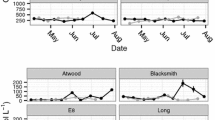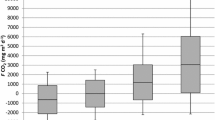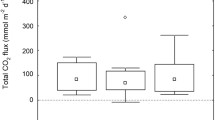Abstract
Ponds are active components of the global carbon cycle processing and emitting carbon dioxide and methane to the atmosphere. These common habitats frequently experience seasonal water table variations resulting in periodically air-exposed sediments. However, the influence of these events on both the system scale carbon balance and in-pond environmental conditions remains poorly studied. We took advantage of an extraordinarily warm and dry summer to quantify the CO2 efflux from air-exposed sediments and water surfaces in desiccating ponds on Öland, Sweden. Simultaneously, we modelled metabolism and measured environmental variables within the ponds. We found that air-exposed sediments had high CO2 effluxes greatly exceeding that from the water surfaces. Sediment water content influenced the temperature and strongly regulated the CO2 efflux gradually approaching zero as water evaporated. Within the desiccating ponds, respiration was generally higher than gross primary production, but was lower compared to the same ponds with higher water table. These findings highlight the role of periodically air-exposed pond sediments as sites of highly active carbon processes. Not only is this important for the system-scale carbon in ponds, but it may also influence the destiny of buried carbon in lakes subject to climate changes. The environmental conditions within desiccating ponds, most notably high water temperatures and poor oxygen conditions, further iterate the dynamics and extreme nature of ponds.







Similar content being viewed by others
References
Abril G et al (2015) Large overestimation of pCO2 calculated from pH and alkalinity in acidic, organic-rich freshwaters. Biogeosciences 12:67–78. https://doi.org/10.5194/bg-12-67-2015
Andersen MR, Kragh T, Sand-Jensen K (2017a) Extreme diel oxygen and carbon cycles in shallow vegetated lakes. Proc R Soc B 284:20171427. https://doi.org/10.1098/rspb.2017.1427
Andersen MR, Sand-Jensen K, Iestyn Woolway R, Jones ID (2017b) Profound daily vertical stratification and mixing in a small, shallow, wind-exposed lake with submerged macrophytes. Aquat Sci 79:395–406. https://doi.org/10.1007/s00027-016-0505-0
Andersen MR, Kragh T, Martinsen KT, Kristensen E, Sand-Jensen K (2019) The carbon pump supports high primary production in a shallow lake Aquat Sci 81:24. https://doi.org/10.1007/s00027-019-0622-7
Baastrup-Spohr L, Kragh T, Petersen K, Moeslund B, Schou JC, Sand-Jensen K (2016a) Remarkable richness of aquatic macrophytes in 3-years old re-established Lake Fil. Denmark Ecol Eng 95:375–383. https://doi.org/10.1016/j.ecoleng.2016.06.081
Baastrup-Spohr L, Møller CL, Sand-Jensen K (2016b) Water-level fluctuations affect sediment properties, carbon flux and growth of the isoetid Littorella uniflora in oligotrophic lakes. Freshw Biol 61:301–315. https://doi.org/10.1111/fwb.12704
Barko JW, Smart RM (1986) Sediment-related mechanisms of growth limitation in submersed macrophytes. Ecology 67:1328–1340. https://doi.org/10.2307/1938689
Barton K (2018) MuMIn: Multi-Model Inference, R package version 1.40.4. https://CRAN.R-project.org/package=MuMIn
Bastviken D, Sundgren I, Natchimuthu S, Reyier H, Gålfalk M (2015) Technical Note: cost-efficient approaches to measure carbon dioxide (CO2) fluxes and concentrations in terrestrial and aquatic environments using mini loggers. Biogeosciences 12:3849–3859. https://doi.org/10.5194/bg-12-3849-2015
Bates BC, Kundzewicz ZW, Wu S, Palutikof JP (2008) Climate Change and Water. Technical Paper of the Intergovernmental Panel on Climate Change, IPCC Secretariat, World Health Organization, Geneva
Bates D, Mächler M, Bolker B, Walker S (2015) Fitting linear mixed-effects models using lme. J Stat Software 67:1–48
Batt RD, Carpenter SR (2012) Free-water lake metabolism: addressing noisy time series with a Kalman filter. Limnol Oceanogr Methods 10:20–30. https://doi.org/10.4319/lom.2012.10.20
Biggs J, von Fumetti S, Kelly-Quinn M (2017) The importance of small waterbodies for biodiversity and ecosystem services: implications for policy makers. Hydrobiologia 793:3–39. https://doi.org/10.1007/s10750-016-3007-0
Bolker BM, Brooks ME, Clark CJ, Geange SW, Poulsen JR, Stevens MHH, White J-SS (2009) Generalized linear mixed models: a practical guide for ecology and evolution. Trends Ecol Evol 24:127–135. https://doi.org/10.1016/j.tree.2008.10.008
Brothers S, Kazanjian G, Köhler J, Scharfenberger U, Hilt S (2017) Convective mixing and high littoral production established systematic errors in the diel oxygen curves of a shallow, eutrophic lake. Limnol Oceanogr Methods 15:429–435. https://doi.org/10.1002/lom3.10169
Burnham KP, Anderson DR (2002) Model selection and multimodel inference: a practical information-theoretic approach. Springer, New York
Casselman JM, Lewis CA (1996) Habitat requirements of northern pike (Essox lucius). Can J Fish Aquat Sci 53:161–174. https://doi.org/10.1139/f96-019
Catalán N, von Schiller D, Marcé R, Koschorreck M, Gomez-Gener L, Obrador B (2014) Carbon dioxide efflux during the flooding phase of temporary ponds. Limnetica 33:349–360
Cavalcanti JR, da Motta-Marques D, Fragoso CR Jr (2016) Process-based modeling of shallow lake metabolism: spatio-temporal variability and relative importance of individual processes. Ecol Model 323:28–40. https://doi.org/10.1016/j.ecolmodel.2015.11.010
Christensen J, Sand-Jensen K, Staehr PA (2013) Fluctuating water levels control water chemistry and metabolism of a charophyte-dominated pond. Freshw Biol 58:1353–1365. https://doi.org/10.1111/fwb.12132
Cole JJ et al (2007) Plumbing the global carbon cycle: integrating inland waters into the terrestrial carbon budget. Ecosystems 10:172–185. https://doi.org/10.1007/s10021-006-9013-8
Downing J et al (2006) The global abundance and size distribution of lakes, ponds, and impoundments. Limnol Oceanogr 51:2388–2397. https://doi.org/10.4319/lo.2006.51.5.2388
Downing JA et al (2008) Sediment organic carbon burial in agriculturally eutrophic impoundments over the last century. Global Biogeochem Cycles 22:1. https://doi.org/10.1029/2006gb002854
Dv Schiller, Marce R, Obrador B, Gomez-Gener L, Casas-Ruiz JP, Acuna V, Koschorreck M (2014) Carbon dioxide emissions from dry watercourses. Inland waters 4:377–382
Fromin N, Pinay G, Montuelle B, Landais D, Ourcival J, Joffre R, Lensi R (2010) Impact of seasonal sediment desiccation and rewetting on microbial processes involved in greenhouse gas emissions. Ecohydrology 3:339–348. https://doi.org/10.1002/eco.115
Gallo EL, Lohse KA, Ferlin CM, Meixner T, Brooks PD (2014) Physical and biological controls on trace gas fluxes in semi-arid urban ephemeral waterways. Biogeochemistry 121:189–207. https://doi.org/10.1007/s10533-013-9927-0
Gilbert PJ, Cooke DA, Deary M, Taylor S, Jeffries MJ (2017) Quantifying rapid spatial and temporal variations of CO2 fluxes from small, lowland freshwater ponds. Hydrobiologia 793:83–93. https://doi.org/10.1007/s10750-016-2855-y
Gómez-Gener L et al (2015) Hot spots for carbon emissions from Mediterranean fluvial networks during summer drought. Biogeochemistry 125:409–426. https://doi.org/10.1007/s10533-015-0139-7
Gómez-Gener L et al (2016) When water vanishes: magnitude and regulation of carbon dioxide emissions from dry temporary streams. Ecosystems 19:710–723. https://doi.org/10.1007/s10021-016-9963-4
Gran G (1952) Determination of the equivalence point in potentiometric titrations. Part II. Analyst 77:661–671. https://doi.org/10.1039/an9527700661
Griffiths RA (1997) Temporary ponds as amphibian habitats. Aquat Conserv 7:119–126
Grinham A et al (2018) The importance of small artificial water bodies as sources of methane emissions in Queensland, Australia. Hydrol Earth Syst Sci 22:5281–5298. https://doi.org/10.5194/hess-2018-294
Hecnar SJ, M’Closkey RT (1997) The effects of predatory fish on amphibian species richness and distribution. Biol Conserv 79:123–131. https://doi.org/10.1016/s0006-3207(96)00113-9
Holgerson MA, Raymond PA (2016) Large contribution to inland water CO2 and CH4 emissions from very small ponds. Nat Geosci 9:222–226. https://doi.org/10.1038/ngeo2654
Jassby AD, Platt T (1976) Mathematical formulation of the relationship between photosynthesis and light for phytoplankton. Limnol Oceanogr 21:540–547. https://doi.org/10.4319/lo.1976.21.4.0540
Jin H, Yoon TK, Lee S-H, Kang H, Im J, Park J-H (2016) Enhanced greenhouse gas emission from exposed sediments along a hydroelectric reservoir during an extreme drought event. Environ Res Lett 11:124003. https://doi.org/10.1088/1748-9326/11/12/124003
Jørgensen SE, Bendoricchio G (2001) Developments in environmental modelling. In: Jørgensen SE, Bendoricchio G (eds) Fundamentals of ecological modelling. vol 21. Elsevier, Amsterdam
Koschorreck M (2000) Methane turnover in exposed sediments of an Amazon floodplain lake. Biogeochemistry 50:195–206. https://doi.org/10.1023/A:1006326018597
Kosten S et al (2018) Extreme drought boosts CO2 and CH4 emissions from reservoir drawdown areas. Inland Waters 8:329–340. https://doi.org/10.1080/20442041.2018.1483126
Kragh T, Andersen MR, Sand-Jensen K (2017) Profound afternoon depression of ecosystem production and nighttime decline of respiration in a macrophyte-rich, shallow lake. Oecologia 185:157–170. https://doi.org/10.1007/s00442-017-3931-3
Leon E, Vargas R, Bullock S, Lopez E, Panosso AR, La Scala N (2014) Hot spots, hot moments, and spatio-temporal controls on soil CO2 efflux in a water-limited ecosystem. Soil Biol Biochem 77:12–21. https://doi.org/10.1016/j.soilbio.2014.05.029
Lloyd J, Taylor J (1994) On the temperature dependence of soil respiration. Funct Ecol 8:315–323. https://doi.org/10.2307/2389824
Marcé R et al (2019) Emissions from dry inland waters are a blind spot in the global carbon cycle Earth-Sci Rev 188:240–248. https://doi.org/10.1016/j.earscirev.2018.11.012
Martinsen KT, Andersen MR, Kragh T, Sand-Jensen K (2017) High rates and close diel coupling of primary production and ecosystem respiration in small, oligotrophic lakes. Aquat Sci 79:995–1007. https://doi.org/10.1007/s00027-017-0550-3
Martinsen KT, Kragh T, Sand-Jensen K (2018) Technical note: a simple and cost-efficient automated floating chamber for continuous measurements of carbon dioxide gas flux on lakes. Biogeosciences 15:5565–5573. https://doi.org/10.5194/bg-15-5565-2018
Martinsen KT, Andersen MR, Sand-Jensen K (2019) Water temperature dynamics and the prevalence of daytime stratification in small temperate shallow lakes. Hydrobiologia 826:247–262. https://doi.org/10.1007/s10750-018-3737-2
Mendonça R, Müller RA, Clow D, Verpoorter C, Raymond P, Tranvik LJ, Sobek S (2017) Organic carbon burial in global lakes and reservoirs. Nat Commun 8:1694. https://doi.org/10.1038/s41467-017-01789-6
Mishra AK, Singh VP (2010) A review of drought concepts. J Hydrol 391:202–216. https://doi.org/10.1016/j.jhydrol.2010.07.012
Nakagawa S, Schielzeth H (2013) A general and simple method for obtaining R2 from generalized linear mixed-effects models. Methods Ecol Evol 4:133–142. https://doi.org/10.1111/j.2041-210x.2012.00261.x
Obrador B, von Schiller D, Marcé R, Gómez-Gener L, Koschorreck M, Borrego C, Catalán N (2018) Dry habitats sustain high CO2 emissions from temporary ponds across seasons. Sci Rep 8:3015. https://doi.org/10.1038/s41598-018-20969-y
Pekel J-F, Cottam A, Gorelick N, Belward AS (2016) High-resolution mapping of global surface water and its long-term changes. Nature 540:418–422. https://doi.org/10.1038/nature20584
Prairie YT et al (2018) Greenhouse gas emissions from freshwater reservoirs: what does the atmosphere see? Ecosystems 21:1058–1071. https://doi.org/10.1007/s10021-017-0198-9
R Core Team (2018) R: a language and environment for statistical computing. R Foundation for Statistical Computing, Vienna
Raat AJ (1988) Synopsis of biological data on the northern pike: Esox lucius Linnaeus, 1758. FAO Fish. Synop., (30) Rev. 2
Raich JW, Schlesinger WH (1992) The global carbon dioxide flux in soil respiration and its relationship to vegetation and climate. Tellus B 44:81–99. https://doi.org/10.1034/j.1600-0889.1992.t01-1-00001.x
Raymond PA et al (2013) Global carbon dioxide emissions from inland waters. Nature 503:355–359. https://doi.org/10.1038/nature12760
Read JS et al (2011) Derivation of lake mixing and stratification indices from high-resolution lake buoy data. Environ Model Software 26:1325–1336. https://doi.org/10.1016/j.envsoft.2011.05.006
Sand-Jensen K, Møller CL (2014) Reduced root anchorage of freshwater plants in sandy sediments enriched with fine organic matter. Freshw Biol 59:427–437. https://doi.org/10.1111/fwb.12275
Sand-Jensen K, Pedersen MF, Nielsen SL (1992) Photosynthetic use of inorganic carbon among primary and secondary water plants in streams. Freshw Biol 27:283–293. https://doi.org/10.1111/j.1365-2427.1992.tb00540.x
Sand-Jensen K, Pedersen NL, Søndergaard M (2007) Bacterial metabolism in small temperate streams under contemporary and future climates. Freshw Biol 52:2340–2353
Sand-Jensen K, Baastrup-Spohr L, Christensen JP, Alnoee AB, Andersen MR, Jespersen TS, Riis T, Bruun HH (2015) Mellan torka och översvämning på Öland. [Caught between draught and flooding on Öland’s Great Alvar.] Svensk Bot Tidskr 109:28–35
Sand-Jensen K et al (2018) Photosynthesis and calcification of charophytes. Aquat Bot 149:46–51. https://doi.org/10.1016/j.aquabot.2018.05.005
Skinner D, Oliver R, Aldridge K, Brookes J (2014) Extreme water level decline effects sediment distribution and composition in Lake Alexandrina, South Australia. Limnology 15:117–126. https://doi.org/10.1007/s10201-013-0422-z
SMHI (2018) Swedish Meteorological and Hydrological Institute. http://www.smhi.se/klimatdata. Accessed February 2019
Solomon CT et al (2013) Ecosystem respiration: drivers of daily variability and background respiration in lakes around the globe. Limnol Oceanogr 58:849–866. https://doi.org/10.4319/lo.2013.58.3.0849
Staehr PA et al (2010) Lake metabolism and the diel oxygen technique: state of the science. Limnol Oceanogr Methods 8:628–644. https://doi.org/10.4319/lom.2010.8.0628
Taylor S, Gilbert PJ, Cooke DA, Deary ME, Jeffries MJ (2019) High carbon burial rates by small ponds in the landscape. Front Ecol Environ 17:25–31. https://doi.org/10.1002/fee.1988
Tranvik LJ et al (2009) Lakes and reservoirs as regulators of carbon cycling and climate. Limnol Oceanogr 54:2298–2314. https://doi.org/10.4319/lo.2009.54.6_part_2.2298
Vargas R, Sánchez-Cañete PE, Serrano-Ortiz P, Curiel Yuste J, Domingo F, López-Ballesteros A, Oyonarte C (2018) Hot-moments of Soil CO2 efflux in a water-limited grassland. Soil Systems 2:47. https://doi.org/10.3390/soilsystems2030047
Verpoorter C, Kutser T, Seekell DA, Tranvik LJ (2014) A global inventory of lakes based on high-resolution satellite imagery. Geophys Res Lett 41:6396–6402. https://doi.org/10.1002/2014gl060641
Wantzen KM, Rothhaupt K-O, Mörtl M, Cantonati M, László G, Fischer P (2008) Ecological effects of water-level fluctuations in lakes: an urgent issue. Hydrobiologia 613:1–4. https://doi.org/10.1007/978-1-4020-9192-6_1
Weise L et al (2016) Water level changes affect carbon turnover and microbial community composition in lake sediments FEMS. Microbiol Ecol 92:fiw035. https://doi.org/10.1093/femsec/fiw035
Weyhenmeyer GA, Kortelainen P, Sobek S, Müller R, Rantakari M (2012) Carbon dioxide in boreal surface waters: a comparison of lakes and streams. Ecosystems 15:1295–1307. https://doi.org/10.1007/s10021-012-9585-4
Williams DD (1997) Temporary ponds and their invertebrate communities. Aquat Conserv 7:105–117
Williams P, Whitfield M, Biggs J, Bray S, Fox G, Nicolet P, Sear D (2004) Comparative biodiversity of rivers, streams, ditches and ponds in an agricultural landscape in Southern England. Biol Conserv 115:329–341. https://doi.org/10.1016/s0006-3207(03)00153-8
Acknowledgements
We are thankful for grant support from COWIfonden and the Carlsberg Foundation (CF14-0136) to Kaj Sand-Jensen to the study of environmental and biological dynamics in ponds. We thank the two anonymous reviewers for their constructive comments which helped improve the manuscript.
Author information
Authors and Affiliations
Corresponding author
Additional information
Responsible Editor: Chris D. Evans.
Publisher's Note
Springer Nature remains neutral with regard to jurisdictional claims in published maps and institutional affiliations.
Electronic supplementary material
Below is the link to the electronic supplementary material.
Rights and permissions
About this article
Cite this article
Martinsen, K.T., Kragh, T. & Sand-Jensen, K. Carbon dioxide fluxes of air-exposed sediments and desiccating ponds. Biogeochemistry 144, 165–180 (2019). https://doi.org/10.1007/s10533-019-00579-0
Received:
Accepted:
Published:
Issue Date:
DOI: https://doi.org/10.1007/s10533-019-00579-0




